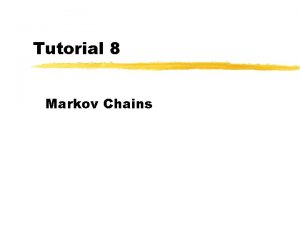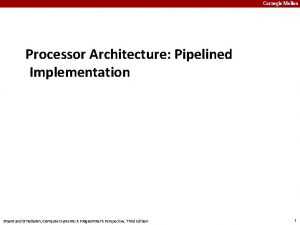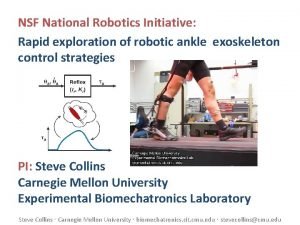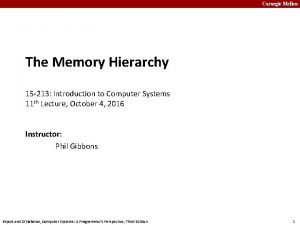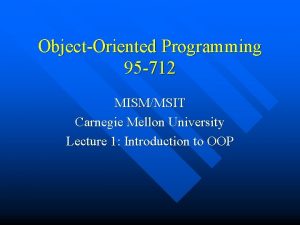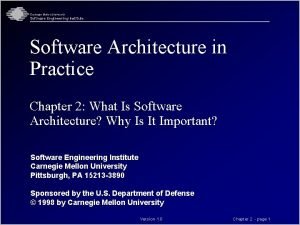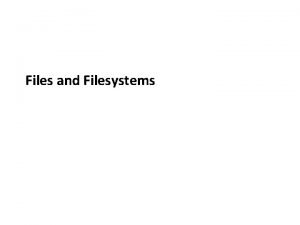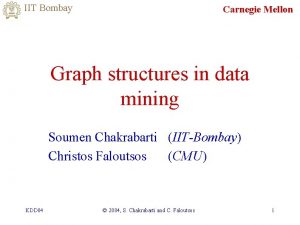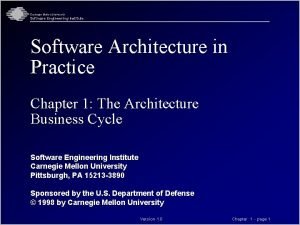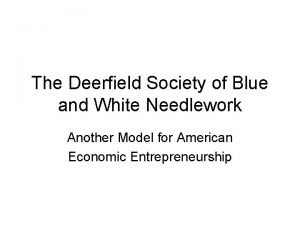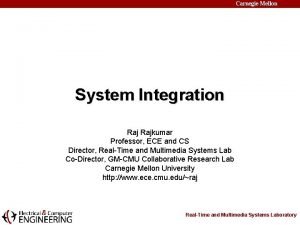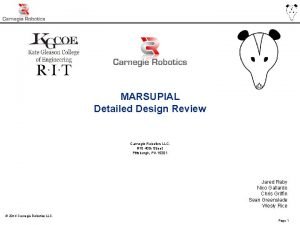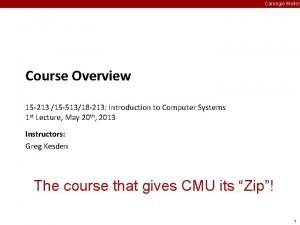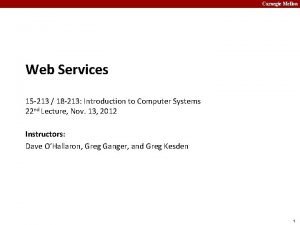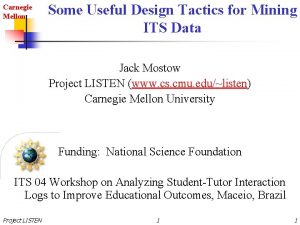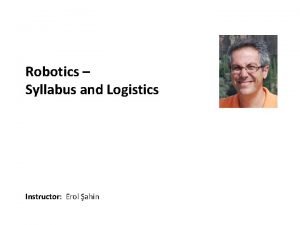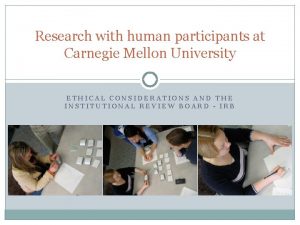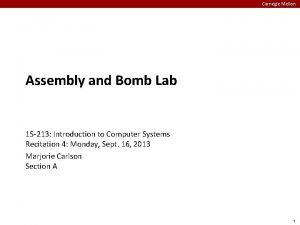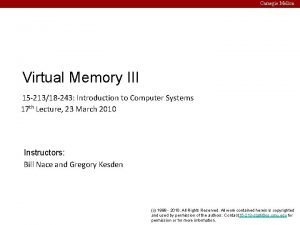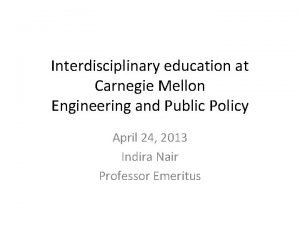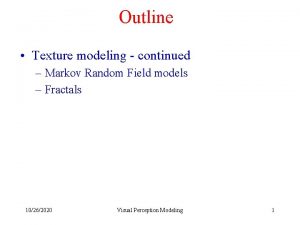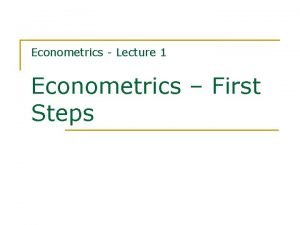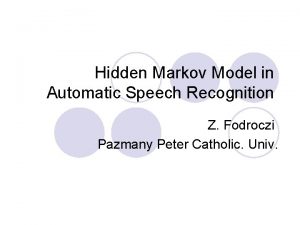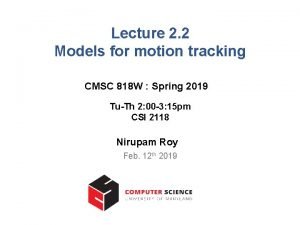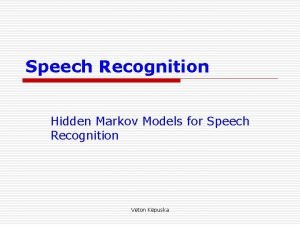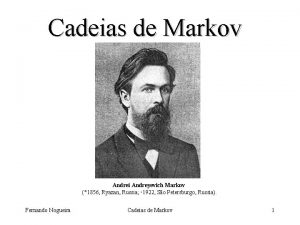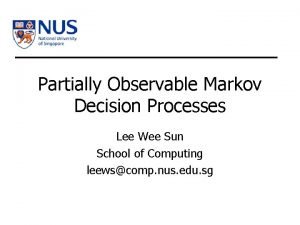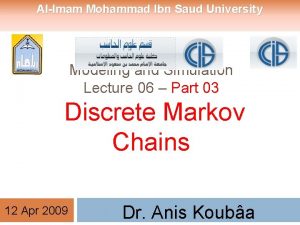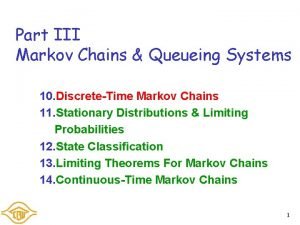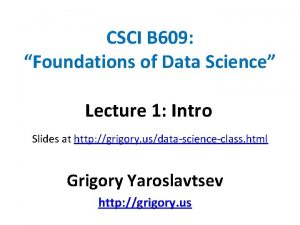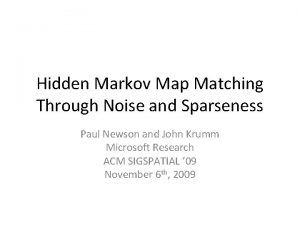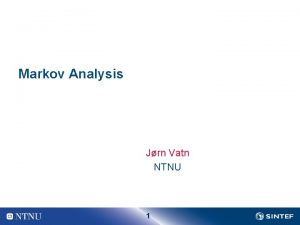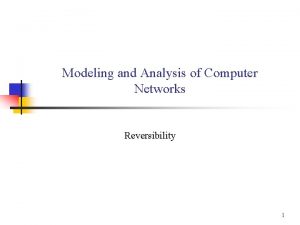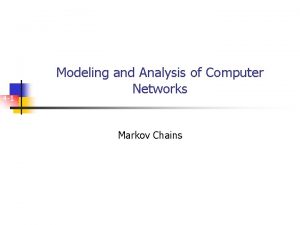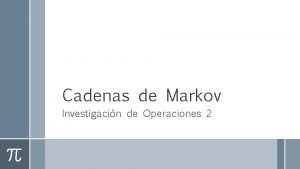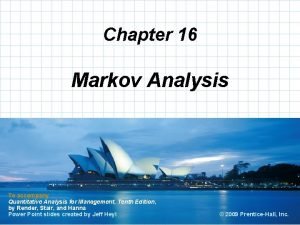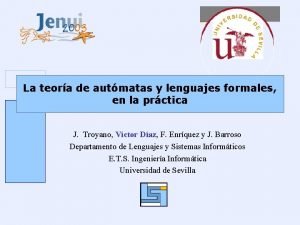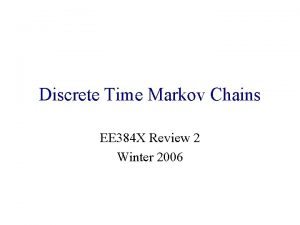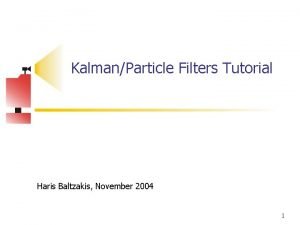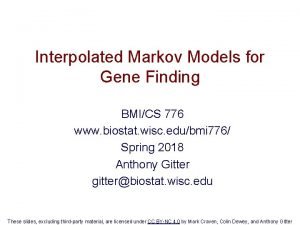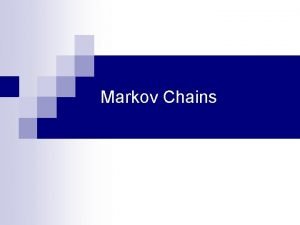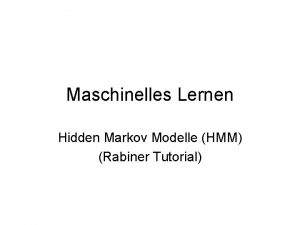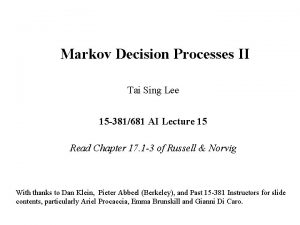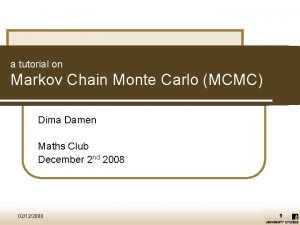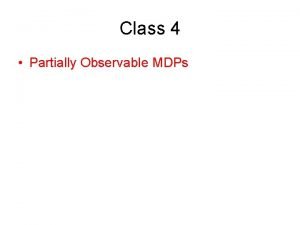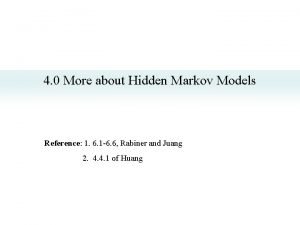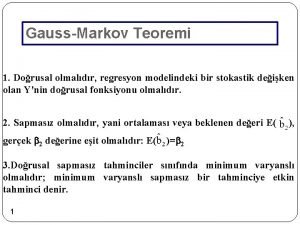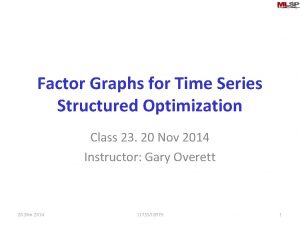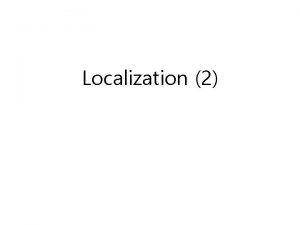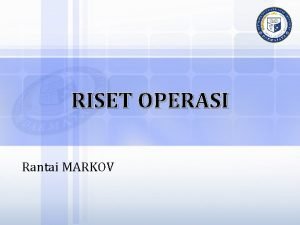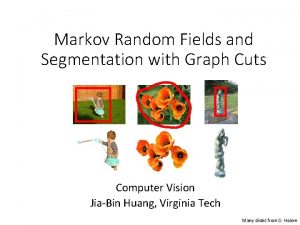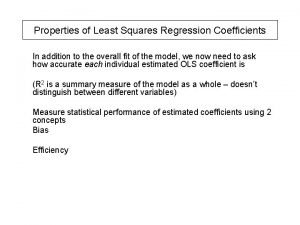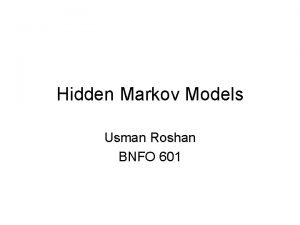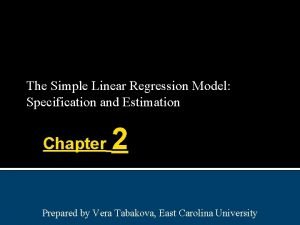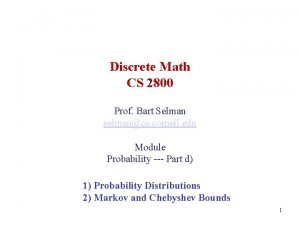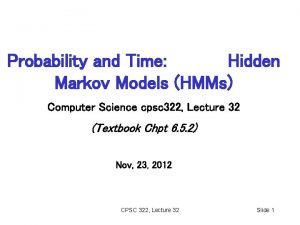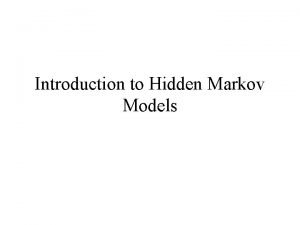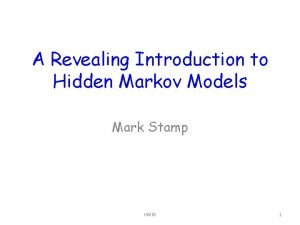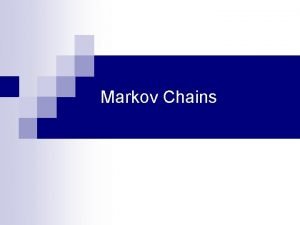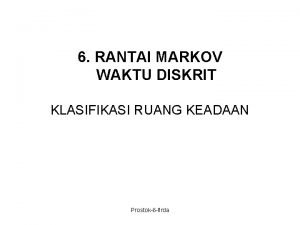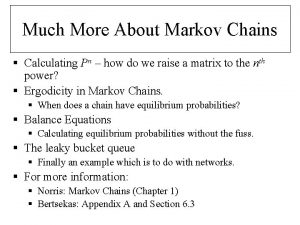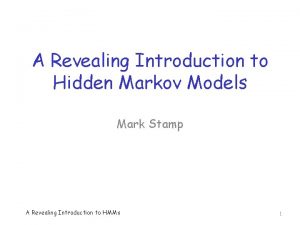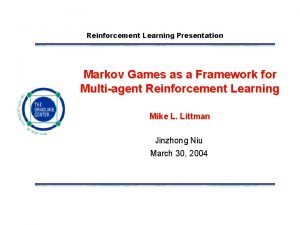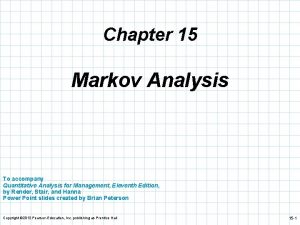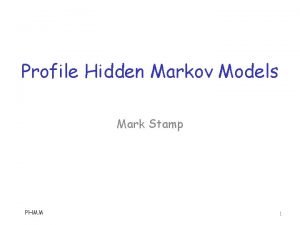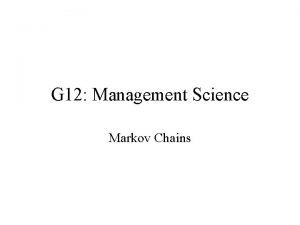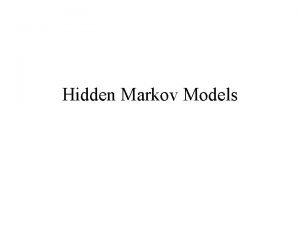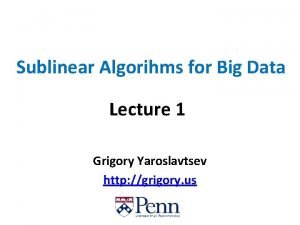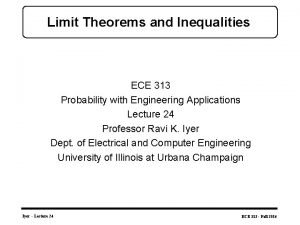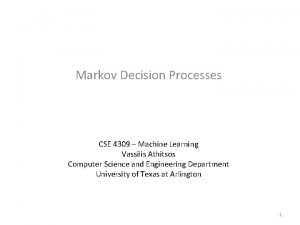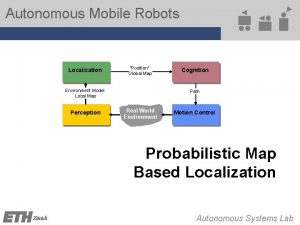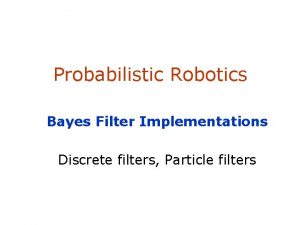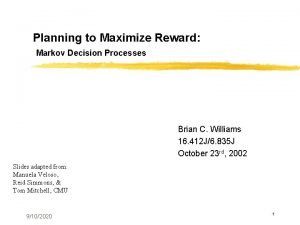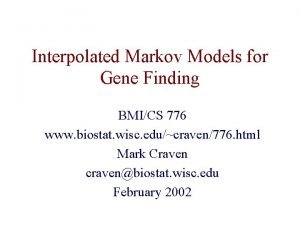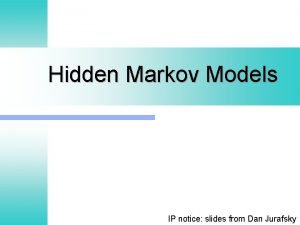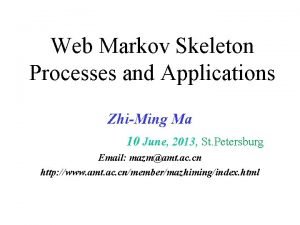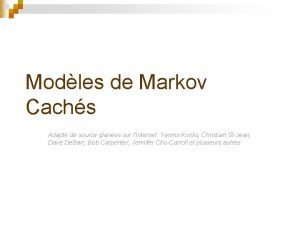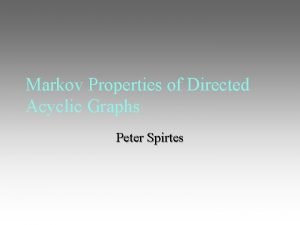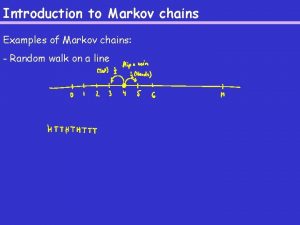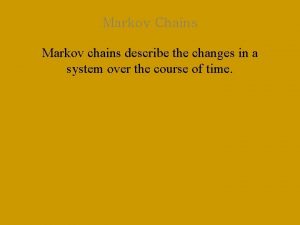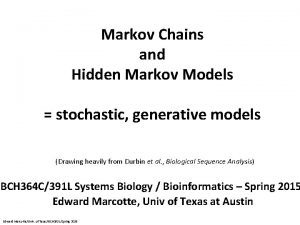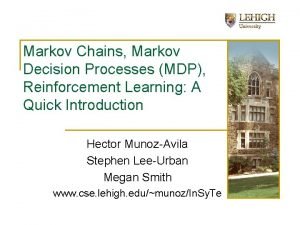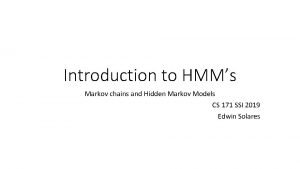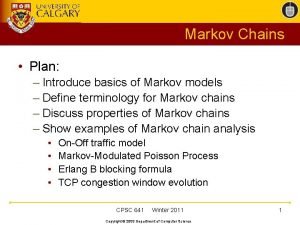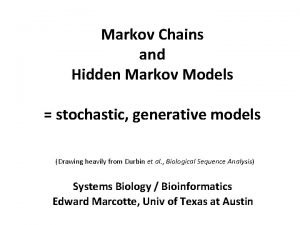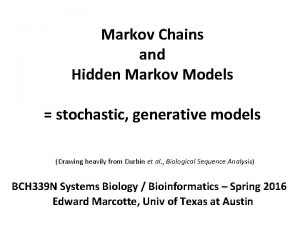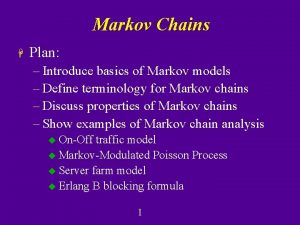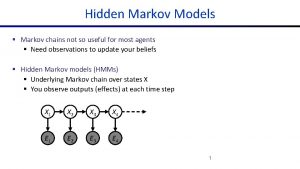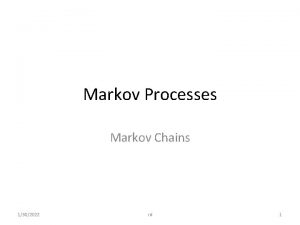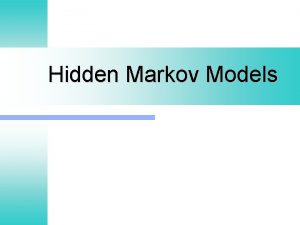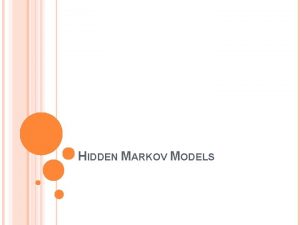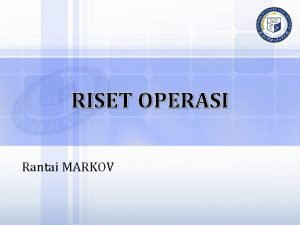Highdimensional integration without Markov chains Alexander Gray Carnegie











![NAIS [Zhang, JASA 1996] Assume f() is a density. 1. Generate x’s from an NAIS [Zhang, JASA 1996] Assume f() is a density. 1. Generate x’s from an](https://slidetodoc.com/presentation_image_h/915e5b2733bdf616db2fedd79e66fb37/image-12.jpg)
![Some attempts for q() • Kernel density estimation [e. g. Zhang, JASA 1996] – Some attempts for q() • Kernel density estimation [e. g. Zhang, JASA 1996] –](https://slidetodoc.com/presentation_image_h/915e5b2733bdf616db2fedd79e66fb37/image-13.jpg)









![Error estimate cf. [Neal 1996]: Use - indirect and approximate argument - can use Error estimate cf. [Neal 1996]: Use - indirect and approximate argument - can use](https://slidetodoc.com/presentation_image_h/915e5b2733bdf616db2fedd79e66fb37/image-23.jpg)








![Observation #3: NWR is a ‘generalized N-body problem’. • distances between n-tuples [pairs] of Observation #3: NWR is a ‘generalized N-body problem’. • distances between n-tuples [pairs] of](https://slidetodoc.com/presentation_image_h/915e5b2733bdf616db2fedd79e66fb37/image-32.jpg)















![Competitors • Standard Monte Carlo • MCMC (Metropolis-Hastings) – starting point [Gelman-Roberts-Gilks 95] – Competitors • Standard Monte Carlo • MCMC (Metropolis-Hastings) – starting point [Gelman-Roberts-Gilks 95] –](https://slidetodoc.com/presentation_image_h/915e5b2733bdf616db2fedd79e66fb37/image-48.jpg)



![Extension #1 Non-positive functions Positivization [Owen-Zhou 1998] Extension #1 Non-positive functions Positivization [Owen-Zhou 1998]](https://slidetodoc.com/presentation_image_h/915e5b2733bdf616db2fedd79e66fb37/image-52.jpg)
![Extension #2 More defensiveness, and accuracy Control variates [Veach 1997] Extension #2 More defensiveness, and accuracy Control variates [Veach 1997]](https://slidetodoc.com/presentation_image_h/915e5b2733bdf616db2fedd79e66fb37/image-53.jpg)















![kd-trees: most widely-used spacepartitioning tree [Friedman, Bentley & Finkel 1977] • Univariate axis-aligned splits kd-trees: most widely-used spacepartitioning tree [Friedman, Bentley & Finkel 1977] • Univariate axis-aligned splits](https://slidetodoc.com/presentation_image_h/915e5b2733bdf616db2fedd79e66fb37/image-69.jpg)






![A ball-tree: level 1 [Uhlmann 1991], [Omohundro 1991] A ball-tree: level 1 [Uhlmann 1991], [Omohundro 1991]](https://slidetodoc.com/presentation_image_h/915e5b2733bdf616db2fedd79e66fb37/image-76.jpg)
















































- Slides: 124

High-dimensional integration without Markov chains Alexander Gray Carnegie Mellon University School of Computer Science

High-dimensional integration by: • Nonparametric statistics • Computational geometry • Computational physics • Monte Carlo methods • Machine learning • . . . …but NOT Markov chains.

The problem Compute where Often: We can evaluate f(x) at any x. But we have no other special knowledge about f. Often f(x) expensive to evaluate. Motivating example: Bayesian inference on large datasets

Curse of dimensionality Quadrature doesn’t extend: O(m. D). How to get the job done (Monte Carlo): 1. Importance sampling (IS) [not general] 2. Markov Chain Monte Carlo (MCMC) Often:

MCMC (Metropolis-Hastings algorithm) 1. 2. 3. 4. 5. Start at random x Sample xnew from N(x, s) Draw u ~ U[0, 1] If u < min(f(xnew)/f(x), 1), set x to xnew Return to step 2.

MCMC (Metropolis-Hastings algorithm) Do this a huge number of times. Analyze the stream of x’s so far by hand to see if you can stop the process. If you jump around f long enough (make a sequence long enough) and draw x’s from it uniformly, these x’s act as if drawn iid from f. Then

Good Really cool: – Ultra-simple – Requires only evaluations of f – Faster than quadrature in high dimensions gave us the bomb (? ? ) listed in “Top 10 algorithms of all time”

Bad Really unfortunate: 1. No reliable way to choose the scale s; yet, its choice is critical for good performance 2. With multiple modes, can get stuck 3. Correlated sampling is hard to characterize in terms of error 4. Prior knowledge can be incorporated only in simple ways 5. No way to reliably stop automatically Requires lots of runs/tuning/guesswork. Many workarounds, for different knowledge about f. (Note that in general case, almost nothing has changed. ) Must become an MCMC expert just to do integrals. (…and the ugly) In the end, we can’t be quite sure about our answer. Black art. Not yet in Numerical Recipes.

Let’s try to make a new method Goal: – Simple like MCMC – Weak/no requirements on f() – Principled and automatic choice of key parameter(s) – Real error bounds – Better handling of isolated modes – Better incorporation of prior knowledge – Holy grail: automatic stopping rule

Importance sampling • Choose q() close to f() if you can; try not to underestimate f() • Unbiased • Error is easier to analyze/measure • But: not general (need to know something about f)

Adaptive importance sampling Idea: can we improve q() as go along? Sample from q() Re-estimate q() from samples By the way… Now we’re doing integration by statistical inference.
![NAIS Zhang JASA 1996 Assume f is a density 1 Generate xs from an NAIS [Zhang, JASA 1996] Assume f() is a density. 1. Generate x’s from an](https://slidetodoc.com/presentation_image_h/915e5b2733bdf616db2fedd79e66fb37/image-12.jpg)
NAIS [Zhang, JASA 1996] Assume f() is a density. 1. Generate x’s from an initial q() 2. Estimate density fhat from the x’s, using kernel density estimation (KDE): 3. Sample x’s from fhat. 4. Return to step 2.
![Some attempts for q Kernel density estimation e g Zhang JASA 1996 Some attempts for q() • Kernel density estimation [e. g. Zhang, JASA 1996] –](https://slidetodoc.com/presentation_image_h/915e5b2733bdf616db2fedd79e66fb37/image-13.jpg)
Some attempts for q() • Kernel density estimation [e. g. Zhang, JASA 1996] – O(N 2); choice of bandwidth • Gaussian process regression [e. g. Rasmussen. Ghahramani, NIPS 2002] – O(N 3); choice of bandwidth • Mixtures (of Gaussians, betas…) [e. g. Owen-Zhou 1998] – nonlinear unconstrained optimization is itself time-consuming and contributes variance; choice of k, … • Neural networks [e. g. JSM 2003] – (let’s get serious) awkward to sample from; like mixtures but worse Bayesian quadrature: right idea but not general

None of these works (i. e. is a viable alternative to MCMC)

Tough questions • Which q()? – ability to sample from it – efficiently computable – reliable and automatic parameter estimation • • • How to avoid getting trapped? Can we actively choose where to sample? How to estimate error at any point? When to stop? How to incorporate prior knowledge?

What’s the right thing to do? (i. e. what objective function should we be optimizing? )

Is this active learning (aka optimal experiment design)? Basic framework: bias-variance decomposition of leastsquares objective function minimize only variance term Seems reasonable, but: • Is least-squares really the optimal thing to do for our problem (integration)?

Observation #1: Least-squares is somehow not exactly right. • It says to approximate well everywhere. • Shouldn’t we somehow focus more on regions where f() is large?

Back to basics Estimate (unbiased)

Back to basics Variance

Back to basics Optimal q()

Idea #1: Minimize importance sampling error
![Error estimate cf Neal 1996 Use indirect and approximate argument can use Error estimate cf. [Neal 1996]: Use - indirect and approximate argument - can use](https://slidetodoc.com/presentation_image_h/915e5b2733bdf616db2fedd79e66fb37/image-23.jpg)
Error estimate cf. [Neal 1996]: Use - indirect and approximate argument - can use for stopping rule

What kind of estimation?

Observation #2: Regression, not density estimation. (even if f() is a density) • Supervised learning vs unsupervised. • Optimal rate for regression is faster than that of density estimation (kernel estimators, finitesample)

Idea #2: Use Nadaraya-Watson regression (NWR) for q()

Why Nadaraya-Watson? • • • Nonparametric Good estimator (though not best) – optimal rate No optimization procedure needed Easy to add/remove points Easy to sample from – choose xi with probability then draw from N(xi, h*) • Guassian kernel makes non-zero everywhere, sample more widely

How can we avoid getting trapped?

Idea #3: Use defensive mixture for q()

This also answered: “How can we incorporate prior knowledge”?

Can we do NWR tractably?
![Observation 3 NWR is a generalized Nbody problem distances between ntuples pairs of Observation #3: NWR is a ‘generalized N-body problem’. • distances between n-tuples [pairs] of](https://slidetodoc.com/presentation_image_h/915e5b2733bdf616db2fedd79e66fb37/image-32.jpg)
Observation #3: NWR is a ‘generalized N-body problem’. • distances between n-tuples [pairs] of points in a metric space [Euclidean] • modulated by a (symmetric) positive monotonic kernel [pdf] • decomposable operator [summation]

Idea #4: 1. Use fast KDE alg. for denom. 2. Generalize to handle numer.

Extension from KDE to NWR • First: allow weights on each point • Second: allow those weights to be negative • Not hard

Okay, so we can compute NWR efficiently with accuracy. How do we find the bandwidth (accurately and efficiently)?

What about an analytical method? Bias-variance decomposition has many terms that can be estimated (if very roughly) But the real problem is D. Thus, this is not reliable in our setting.

Idea #5: ‘Least-IS-error’ cross-validation

Idea #6: Incremental cross-validation

Idea #7: Simultaneous-bandwidth N-body algorithm We can share work between bandwidths. [Gray and Moore, 2003]

Idea #8: Use ‘equivalent kernels’ transformation • Epanechnikov kernel (optimal) has finite extent • 2 -3 x faster than Gaussian kernel

How can we pick samples in a guided fashion? • Go where we’re uncertain? • Go by the f() value, to ensure low intrinsic dimension for the N-body algorithm?

Idea #9: Sample more where the error was larger • Choose new xi with probability pi • Draw from N(xi, h*)

Should we forget old points? I tried that. It doesn’t work. So I remember all the old samples.

Idea #10: Incrementally update estimates

Overall method: FIRE Repeat: 1. Resample N points from {xi} using Add to training set. Build/update 2. Compute 3. Sample N points {xi} from 4. For each xi compute 5. Update I and V using

Properties • Because FIRE is importance sampling: – consistent – unbiased • The NWR estimate approaches f(x)/I • Somewhat reminiscent of particle filtering; EM-like; like N interacting Metropolis samplers

Test problems • Thin region Anisotropic Gaussian a s 2 in off-diagonals a={0. 99, 0. 5}, D={5, 10, 25, 100} • Isolated modes Mixture of two normals 0. 5 N(4, 1) + 0. 5 N(4+b, 1) b={2, 4, 6, 8, 10}, D={5, 10, 25, 100}
![Competitors Standard Monte Carlo MCMC MetropolisHastings starting point GelmanRobertsGilks 95 Competitors • Standard Monte Carlo • MCMC (Metropolis-Hastings) – starting point [Gelman-Roberts-Gilks 95] –](https://slidetodoc.com/presentation_image_h/915e5b2733bdf616db2fedd79e66fb37/image-48.jpg)
Competitors • Standard Monte Carlo • MCMC (Metropolis-Hastings) – starting point [Gelman-Roberts-Gilks 95] – adaptation phase [Gelman-Roberts-Gilks 95] – burn-in time [Geyer 92] – multiple chains [Geyer 92] – thinning [Gelman 95]

How to compare Look at its relative error over many runs When to stop it? 1. Use its actual stopping criterion 2. Use a fixed wall-clock time

Anisotropic Gaussian (a=0. 9, D=10) • MCMC – started at center of mass – when it wants to stop: >2 hours – after 2 hours • with best s: rel. err {24%, 11%, 3%, 62%} • small s and large s: >250% errors • automatic s: {59%, 16%, 93%, 71%} – ~40 M samples • FIRE – when it wants to stop: ~1 hour – after 2 hours: rel. err {1%, 2%, 1%} – ~1. 5 M samples

Mixture of Gaussians (b=10, D=10) • MCMC – started at one mode – when it wants to stop: ~30 minutes – after 2 hours: • with best s: rel. err {54%, 42%, 58%, 47%} • small s, large s, automatic s: similar – ~40 M samples • FIRE – when it wants to stop: ~10 minutes – after 2 hours: rel. err {<1%, 32%, <1%} – ~1. 2 M samples
![Extension 1 Nonpositive functions Positivization OwenZhou 1998 Extension #1 Non-positive functions Positivization [Owen-Zhou 1998]](https://slidetodoc.com/presentation_image_h/915e5b2733bdf616db2fedd79e66fb37/image-52.jpg)
Extension #1 Non-positive functions Positivization [Owen-Zhou 1998]
![Extension 2 More defensiveness and accuracy Control variates Veach 1997 Extension #2 More defensiveness, and accuracy Control variates [Veach 1997]](https://slidetodoc.com/presentation_image_h/915e5b2733bdf616db2fedd79e66fb37/image-53.jpg)
Extension #2 More defensiveness, and accuracy Control variates [Veach 1997]

Extension #3 More accurate regression Local linear regression

Extension #4 (maybe) Fully automatic stopping Function-wide confidence bands stitch together pointwise bands, control with FDR

Summary • We can do high-dimensional integration without Markov chains, by statistical inference • Promising alternative to MCMC – safer (e. g. isolated modes) – not a black art – faster • Intrinsic dimension - multiple viewpoints • MUCH more work needed – please help me!

One notion of intrinsic dimension log C(r) log r ‘Correlation dimension’ Similar: notion in metric analysis

N-body problems • Coulombic (high accuracy required)

N-body problems • Coulombic (high accuracy required) • Kernel density estimation (only moderate accuracy required, often high-D)

N-body problems • Coulombic (high accuracy required) • Kernel density estimation (only moderate accuracy required, often high-D) • SPH (smoothed particle hydrodynamics) (only moderate accuracy required) Also: different for every point, non-isotropic, edge-dependent, …

N-body methods: Approximation • Barnes-Hut r s if

N-body methods: Approximation • Barnes-Hut r s if • FMM s multipole/Taylor expansion of order p if

N-body methods: Runtime • Barnes-Hut non-rigorous, uniform distribution • FMM non-rigorous, uniform distribution

N-body methods: Runtime • Barnes-Hut non-rigorous, uniform distribution • FMM non-rigorous, uniform distribution [Callahan-Kosaraju 95]: O(N) is impossible for log-depth tree (in the worst case)

Expansions • Constants matter! p. D factor is slowdown • Large dimension infeasible • Adds much complexity (software, human time) • Non-trivial to do new kernels (assuming they’re even analytic), heterogeneous kernels

Expansions • Constants matter! p. D factor is slowdown • Large dimension infeasible • Adds much complexity (software, human time) • Non-trivial to do new kernels (assuming they’re even analytic), heterogeneous kernels • BUT: Needed to achieve O(N) Needed to achieve high accuracy Needed to have hard error bounds

Expansions • Constants matter! p. D factor is slowdown • Large dimension infeasible • Adds much complexity (software, human time) • Non-trivial to do new kernels (assuming they’re even analytic), heterogeneous kernels • BUT: Needed to achieve O(N) (? ) Needed to achieve high accuracy (? ) Needed to have hard error bounds (? )

N-body methods: Adaptivity • Barnes-Hut recursive can use any kind of tree • FMM hand-organized control flow requires grid structure quad-tree/oct-tree kd-tree ball-tree/metric tree not very adaptive
![kdtrees most widelyused spacepartitioning tree Friedman Bentley Finkel 1977 Univariate axisaligned splits kd-trees: most widely-used spacepartitioning tree [Friedman, Bentley & Finkel 1977] • Univariate axis-aligned splits](https://slidetodoc.com/presentation_image_h/915e5b2733bdf616db2fedd79e66fb37/image-69.jpg)
kd-trees: most widely-used spacepartitioning tree [Friedman, Bentley & Finkel 1977] • Univariate axis-aligned splits • Split on widest dimension • O(N log N) to build, O(N) space

A kd-tree: level 1

A kd-tree: level 2

A kd-tree: level 3

A kd-tree: level 4

A kd-tree: level 5

A kd-tree: level 6
![A balltree level 1 Uhlmann 1991 Omohundro 1991 A ball-tree: level 1 [Uhlmann 1991], [Omohundro 1991]](https://slidetodoc.com/presentation_image_h/915e5b2733bdf616db2fedd79e66fb37/image-76.jpg)
A ball-tree: level 1 [Uhlmann 1991], [Omohundro 1991]

A ball-tree: level 2

A ball-tree: level 3

A ball-tree: level 4

A ball-tree: level 5

N-body methods: Comparison runtime Barnes-Hut O(Nlog. N) FMM O(N) expansions optional required simple, recursive? yes no adaptive trees? yes no error bounds? no yes

Questions • What’s the magic that allows O(N)? Is it really because of the expansions? • Can we obtain an method that’s: 1. O(N) 2. lightweight: works with or without. . . . expansions simple, recursive

New algorithm • Use an adaptive tree (kd-tree or ball-tree) • Dual-tree recursion • Finite-difference approximation

Single-tree: Dual-tree (symmetric):

Simple recursive algorithm Single. Tree(q, R) { if approximate(q, R), return. if leaf(R), Single. Tree. Base(q, R). else, Single. Tree(q, R. left). Single. Tree(q, R. right). } (NN or range-search: recurse on the closer node first)

Simple recursive algorithm Dual. Tree(Q, R) { if approximate(Q, R), return. if leaf(Q) and leaf(R), Dual. Tree. Base(Q, R). else, Dual. Tree(Q. left, R. left). Dual. Tree(Q. left, R. right). Dual. Tree(Q. right, R. left). Dual. Tree(Q. right, R. right). } (NN or range-search: recurse on the closer node first)

Dual-tree traversal (depth-first) Query points Reference points

Dual-tree traversal Query points Reference points

Dual-tree traversal Query points Reference points

Dual-tree traversal Query points Reference points

Dual-tree traversal Query points Reference points

Dual-tree traversal Query points Reference points

Dual-tree traversal Query points Reference points

Dual-tree traversal Query points Reference points

Dual-tree traversal Query points Reference points

Dual-tree traversal Query points Reference points

Dual-tree traversal Query points Reference points

Dual-tree traversal Query points Reference points

Dual-tree traversal Query points Reference points

Dual-tree traversal Query points Reference points

Dual-tree traversal Query points Reference points

Dual-tree traversal Query points Reference points

Dual-tree traversal Query points Reference points

Dual-tree traversal Query points Reference points

Dual-tree traversal Query points Reference points

Dual-tree traversal Query points Reference points

Dual-tree traversal Query points Reference points

Finite-difference function approximation. Taylor expansion: Gregory-Newton finite form:

Finite-difference function approximation. assumes monotonic decreasing kernel could also use center of mass Stopping rule: approximate if s > r

Simple approximation method approximate(Q, R) { if incorporate(dl, du). } trivial to change kernel hard error bounds

Runtime analysis THEOREM: Dual-tree algorithm is O(N) in worst case (linear-depth trees) NOTE: Faster algorithm using different approximation rule: O(N) expected case ASSUMPTION: N points from density f

Recurrence for self-finding single-tree (point-node) dual-tree (node-node)

Packing bound LEMMA: Number of nodes that are wellseparated from a query node Q is bounded by a constant Thus the recurrence yields the entire runtime. Done. CONJECTURE: should actually be D’ (the intrinsic dimension).

Real data: SDSS, 2 -D

Speedup Results: Number of points N naïve 12. 5 K 7 25 K 31 50 K 123 100 K 494 200 K 1976* 400 K 7904* 800 K 31616* 1. 6 M 35 hrs dualtree. 12. 31. 46 1. 0 2 5 10 23 5500 x One order-of-magnitude speedup over single-tree at ~2 M points

Speedup Results: Different kernels N Epan. Gauss. 12. 5 K. 12. 32 25 K. 31. 70 50 K. 46 1. 1 100 K 1. 0 2 200 K 2 5 400 K 5 11 800 K 10 22 1. 6 M 23 51 Epanechnikov: 10 -6 relative error Gaussian: 10 -3 relative error

Speedup Results: Dimensionality N Epan. Gauss. 12. 5 K. 12. 32 25 K. 31. 70 50 K. 46 1. 1 100 K 1. 0 2 200 K 2 5 400 K 5 11 800 K 10 22 1. 6 M 23 51

Speedup Results: Different datasets Name N D Time (sec) Bio 5 103 K 5 10 Cov. Type 136 K 38 8 MNIST 10 K 784 24 PSF 2 d 3 M 2 9

Meets desiderata? Kernel density estimation • Accuracy good enough? yes • Separate query and reference datasets? yes • Variable-scale kernels? yes • Multiple scales simultaneously? yes • Nonisotropic kernels? yes • Arbitrary dimensionality? yes (depends on D’<<D) • Allows all desired kernels? mostly • Field-tested, compared to existing methods? yes [Gray and Moore, 2003], [Gray and Moore 2005 in prep. ]

Meets desiderata? Smoothed particle hydrodynamics • • • Accuracy good enough? yes Variable-scale kernels? yes Nonisotropic kernels? yes Allows all desired kernels? yes Edge-effect corrections (mixed kernels)? yes Highly non-uniform data? yes Fast tree-rebuilding? yes, soon perhaps faster Time stepping integrated? no Field-tested, compared to existing methods? no

Meets desiderata? Coulombic simulation • • Accuracy good enough? open question Allows multipole expansions? yes Allows all desired kernels? yes Fast tree-rebuilding? yes, soon perhaps faster Time stepping integrated? no Field-tested, compared to existing methods? no Parallelized? no

Which data structure is best in practice? • consider nearest-neighbor as a proxy (and its variants: approximate, all-nearest-neighbor, bichromatic nearest-neighbor, point location) • kd-trees? Uhlmann’s metric trees? Fukunaga’s metric trees? SR-trees? Miller et al. ’s separator tree? WSPD? navigating nets? Locality-sensitive hashing? • [Gray, Lee, Rotella, Moore] Coming soon to a journal near you

Side note: Many problems are easy for this framework • • Correlation dimension Hausdorff distance Euclidean minimum spanning tree more

Last step… Now use q() to do importance sampling. Compute
 Transition matrix example
Transition matrix example Philanthropy carnegie
Philanthropy carnegie Andrew carnegie vertical integration
Andrew carnegie vertical integration Jp morgan horizontal integration
Jp morgan horizontal integration Andrew carnegie vertical integration
Andrew carnegie vertical integration Jp morgan vertical integration
Jp morgan vertical integration Andrew carnegie vertical integration
Andrew carnegie vertical integration For my father who lived without ceremony
For my father who lived without ceremony Justify the title of keeping quiet
Justify the title of keeping quiet Without title poem by diane glancy
Without title poem by diane glancy Xiaomi bcg matrix
Xiaomi bcg matrix What is simultaneous integration
What is simultaneous integration Three dimensions of corporate strategy
Three dimensions of corporate strategy Carnegie mellon
Carnegie mellon Robotic ankle
Robotic ankle Carnegie hall acadia
Carnegie hall acadia Carnegie mellon computational biology
Carnegie mellon computational biology Carnegie mellon
Carnegie mellon Cmu mism
Cmu mism Carnegie
Carnegie Carnegie mellon software architecture
Carnegie mellon software architecture Carnegie mellon fat letter
Carnegie mellon fat letter Carnegie mellon
Carnegie mellon Carnegie mellon software architecture
Carnegie mellon software architecture Carnegie and rockefeller venn diagram
Carnegie and rockefeller venn diagram Carnegie mellon
Carnegie mellon Bill gates founder of microsoft
Bill gates founder of microsoft Carnegie robotics llc
Carnegie robotics llc Carnegie learning
Carnegie learning Carnegie mellon
Carnegie mellon 18-213 cmu
18-213 cmu Was andrew carnegie a hero
Was andrew carnegie a hero Carnegie
Carnegie Dale carnegie conversation stack
Dale carnegie conversation stack Carnegie mellon
Carnegie mellon Citi training cmu
Citi training cmu Randy pausch time management
Randy pausch time management Carnegie mellon bomb threat
Carnegie mellon bomb threat Modelo de carnegie
Modelo de carnegie Cmu bomb lab
Cmu bomb lab Was andrew carnegie bad
Was andrew carnegie bad Carnegie mellon vpn
Carnegie mellon vpn Jack carnegie
Jack carnegie Carnegie mellon interdisciplinary
Carnegie mellon interdisciplinary Markov
Markov Econometrics
Econometrics Markov model
Markov model Markov localization
Markov localization Markov process adalah
Markov process adalah Markov decision process puterman
Markov decision process puterman Andrei andreyevich markov
Andrei andreyevich markov Markov decision process
Markov decision process Transient markov chain
Transient markov chain Communicating classes markov chain
Communicating classes markov chain Markov inequality proof
Markov inequality proof Markov chain absorbing state
Markov chain absorbing state Contoh kasus, analisis markov
Contoh kasus, analisis markov Veton kepuska
Veton kepuska Hidden markov map matching through noise and sparseness
Hidden markov map matching through noise and sparseness Markov modell
Markov modell Hidden markov model
Hidden markov model Jørn vatn
Jørn vatn Birth and death process examples
Birth and death process examples Markov decision process merupakan tuple dari
Markov decision process merupakan tuple dari Embedded markov chain
Embedded markov chain Cadenas
Cadenas Gauss markov assumptions
Gauss markov assumptions Markov analysis
Markov analysis Cadenas de markov caracteristicas
Cadenas de markov caracteristicas Aperiodic markov chain
Aperiodic markov chain Markov localization
Markov localization Interpolated markov model
Interpolated markov model Pijipin
Pijipin Homogeneous markov chain
Homogeneous markov chain Rabiner hmm
Rabiner hmm Tai sing lee
Tai sing lee Mcmc tutorial
Mcmc tutorial Markov chain natural language processing
Markov chain natural language processing Markov decision
Markov decision Markov
Markov Bing
Bing Gauss markov varsayımları
Gauss markov varsayımları Sestra leke kapetana pesma
Sestra leke kapetana pesma Factor graphs and gtsam: a hands-on introduction
Factor graphs and gtsam: a hands-on introduction Contoh kasus, analisis markov
Contoh kasus, analisis markov Basic concepts of probability
Basic concepts of probability Operations research and supply chain
Operations research and supply chain Markov random field
Markov random field Markov model
Markov model Procesos de markov de primer orden
Procesos de markov de primer orden Cov(ui uj)=0
Cov(ui uj)=0 Hidden markov models
Hidden markov models Gauss markov assumptions
Gauss markov assumptions Markov inequality proof
Markov inequality proof Markov model
Markov model Hidden markov chain
Hidden markov chain Hr utility framework in hrm
Hr utility framework in hrm A revealing introduction to hidden markov models
A revealing introduction to hidden markov models Chapman kolmogorov equation
Chapman kolmogorov equation Rantai markov waktu diskrit
Rantai markov waktu diskrit Aperiodic markov chain
Aperiodic markov chain A revealing introduction to hidden markov models
A revealing introduction to hidden markov models Hidden markov model rock paper scissors
Hidden markov model rock paper scissors Kiểm định sự phù hợp của mô hình hồi quy
Kiểm định sự phù hợp của mô hình hồi quy What is markov analysis
What is markov analysis Phmm
Phmm Aperiodic markov chain
Aperiodic markov chain Markov
Markov Markov's inequality
Markov's inequality Markov inequality proof
Markov inequality proof Ketaksamaan markov
Ketaksamaan markov Markov decision
Markov decision Markov localization
Markov localization Bayes filter
Bayes filter Sasha markov
Sasha markov Markov analysis
Markov analysis Markov decision
Markov decision Markov decision process
Markov decision process Interpolated markov model
Interpolated markov model Hidden markov chain
Hidden markov chain Markov
Markov Aperiodic markov chain
Aperiodic markov chain Hidden markov model tutorial
Hidden markov model tutorial Properties of directed acyclic graph
Properties of directed acyclic graph Contoh soal rantai markov waktu diskrit
Contoh soal rantai markov waktu diskrit
